- Home
- Capacitors
- Polymer
- Tantalum and Polymer FAQs
Tantalum and Polymer FAQs
- Where can I find the KEMET tantalum and polymer product lineup?
- Where do I find typical piece weights for KEMET capacitors?
- What is voltage substitution and why is this done?
- Are tantalum and polymer capacitors ESD-sensitive?
- What is the part number structure used when ordering KEMET capacitors?
- How do I determine the date code on a KEMET capacitor?
- What are the packaging options for tantalum and polymer capacitors?
- How can I obtain detailed specification sheets for KEMET products?
- Where are KEMET tantalum and polymer capacitors manufactured?
- How can I request additional information?
- Do tantalum and polymer capacitors have polarity?
- How many reflows are allowed for tantalum and polymer capacitors?
- What is the KEMET recommended soldering process?
- Can tantalum capacitors be hand soldered with a soldering iron?
- What is MSL and what is the rating for tantalum and polymer capacitors?
- What is the floor life of KEMET tantalum and polymer capacitors?
- What is voltage derating?
- Where do I obtain RoHS, REACH and material declaration documentation?
- What is the outgassing performance of tantalum capacitors?
- What is the tin whisker performance of tantalum capacitors?
- What is the flammability rating of KEMET tantalum and polymer capacitors?
- What is FIT/MTBF and how is it calculated?
- What is SPICE and do you have models available?
- What is failure rate and established reliability?
- What is Weibull Grade and PCRAT?
- What is KEMET F-Tech?
- What is KEMET Simulated Break-Down Screening (SBDS)?
- How do I obtain qualification data for KEMET products?
- Can tantalum and polymer capacitors operate applying reverse voltage?
- Does the capacitance change when a DC voltage is applied to tantalum and polymer capacitors?
- Does the capacitance change over time for tantalum and polymer capacitors?
- What is the frequency characteristic of capacitor's impedance?
- What is voltage derating and what are KEMET recommendations?
- What is surge voltage?
- What is Impedance (Z)/Equivalent Series Resistance (ESR), and Equivalent Series Inductance (ESL)?
- What is ripple current?
- Can MLCCs be replaced with tantalum and polymer?
- What is surge current?
- Are tantalum polymer capacitors sensitive to radiation?
- Where can I find the KEMET tantalum and polymer product lineup?
- Where do I find typical piece weights for KEMET capacitors?
- What is voltage substitution and why is this done?
- Are tantalum and polymer capacitors ESD-sensitive?
- What is the part number structure used when ordering KEMET capacitors?
- How do I determine the date code on a KEMET capacitor?
- What are the packaging options for tantalum and polymer capacitors?
- How can I obtain detailed specification sheets for KEMET products?
- Where are KEMET tantalum and polymer capacitors manufactured?
- How can I request additional information?
- Do tantalum and polymer capacitors have polarity?
- How many reflows are allowed for tantalum and polymer capacitors?
- What is the KEMET recommended soldering process?
- Can tantalum capacitors be hand soldered with a soldering iron?
- What is MSL and what is the rating for tantalum and polymer capacitors?
- What is the floor life of KEMET tantalum and polymer capacitors?
- What is voltage derating?
- Where do I obtain RoHS, REACH and material declaration documentation?
- What is the outgassing performance of tantalum capacitors?
- What is the tin whisker performance of tantalum capacitors?
- What is the flammability rating of KEMET tantalum and polymer capacitors?
- What is FIT/MTBF and how is it calculated?
- What is SPICE and do you have models available?
- What is failure rate and established reliability?
- What is Weibull Grade and PCRAT?
- What is KEMET F-Tech?
- What is KEMET Simulated Break-Down Screening (SBDS)?
- How do I obtain qualification data for KEMET products?
- Can tantalum and polymer capacitors operate applying reverse voltage?
- Does the capacitance change when a DC voltage is applied to tantalum and polymer capacitors?
- Does the capacitance change over time for tantalum and polymer capacitors?
- What is the frequency characteristic of capacitor's impedance?
- What is voltage derating and what are KEMET recommendations?
- What is surge voltage?
- What is Impedance (Z)/Equivalent Series Resistance (ESR), and Equivalent Series Inductance (ESL)?
- What is ripple current?
- Can MLCCs be replaced with tantalum and polymer?
- What is surge current?
- Are tantalum polymer capacitors sensitive to radiation?
Disclaimer
This document is meant to provide general answers to frequently asked questions. All information in this document is for informational purposes only and is not considered a specification. To submit a question, please contact us.
General
Where can I find the KEMET tantalum and polymer product lineup?
Where do I find typical piece weights for KEMET capacitors?
Typical piece weights can be found on the KEMET detailed specification sheets and series datasheets. See below for an example:
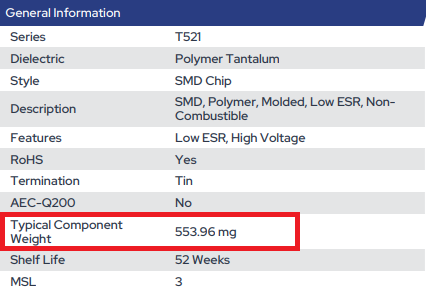
What is voltage substitution and why is this done?
Please be advised that higher voltage substitution is common practice in the capacitor industry and is allowed by the industry standard EIA specifications EIA 535 BAAC for solid tantalum surface mount capacitors and EIC/ECA 797 for solid aluminum electrolytic capacitors. KEMET uses a "parent voltage" concept when designing tantalum and aluminum surface mount capacitors. If a given capacitance value is offered in several different voltage ratings, within the same case size, we may choose to standardize on only the highest one or two voltage ratings for manufacture. These higher ratings may then be substituted for all subordinate voltages. This practice reduces inventory and throughput and increases flexibility in fulfilling customer orders.
It's important to note that customers can request that their order is excluded from this practice by contacting their KEMET representative.
Are tantalum and polymer capacitors ESD-sensitive?
Tantalum and polymer capacitors are not ESD-sensitive devices.
What is the part number structure used when ordering KEMET capacitors?
KEMET tantalum and polymer capacitors use a maximum of 22 characters. Please refer to each product’s data sheet for detailed information on its available options. See below for example:

How do I determine the date code on a KEMET capacitor?
The date code can be found laser marked in the capacitor body. It can vary depending on the component’s case size; please refer to each product’s data sheet for detailed information. See below for example:
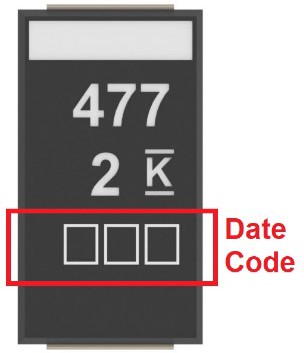
What are the packaging options for tantalum and polymer capacitors?
KEMET molded chip capacitor families are packaged in 8 and 12 mm plastic tape on 7" and 13" reels in accordance with EIA Standard 481: Embossed Carrier Taping of Surface Mount Components for Automatic Handling. This packaging system is compatible with all tape-fed automatic pick-and-place systems. Additional packaging options are available. Please refer to each product’s datasheet for detailed information.
How can I obtain detailed specification sheets for KEMET products?
Specification sheets for KEMET products are easily available via search. Simply search for the part number of interest to display the available support documentation. See below for example:

Where are KEMET tantalum and polymer capacitors manufactured?
KEMET is a leading supplier of electronic components with facilities all over the world. Tantalum and polymer capacitors can be manufactured in different locations, such as the USA, Mexico, China, and Thailand. Please contact your KEMET representative for product specific information.
How can I request additional information?
Please contact your KEMET representative, or use the Contact Us form.
Handling and Mounting
Do tantalum and polymer capacitors have polarity?
Yes, tantalum and polymer capacitors are polar devices. The polarity indicator is clearly laser-marked on the component’s body. See below example:
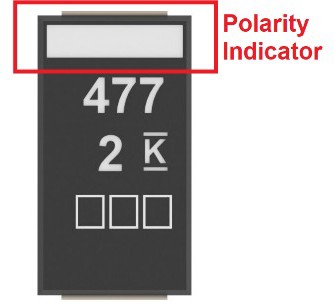
How many reflows are allowed for tantalum and polymer capacitors?
KEMET recommended profile conditions for convection and IR reflow reflect the profile conditions of the IPC/J–STD–020D standard for moisture sensitivity testing. The devices can safely withstand a maximum of three reflow passes at these conditions.
What is the KEMET recommended soldering process?
The KEMET families of surface mount capacitors are compatible with wave (single or dual), convection, IR, or vapor phase reflow techniques. Preheating of these components is recommended to avoid extreme thermal stress. Recommended solder profile below:
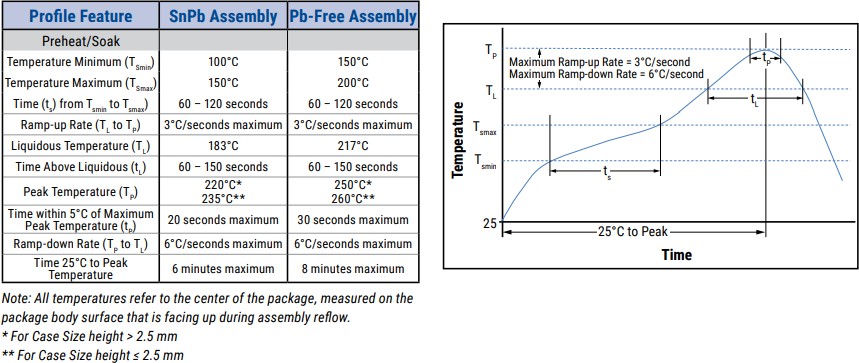
Can tantalum capacitors be hand soldered with a soldering iron?
Hand soldering should be performed with care due to the difficulty in process control. If performed, care should be taken to avoid contact of the soldering iron to the molded case. The iron should be used to heat the solder pad, applying solder between the pad and the termination, until reflow occurs. Once reflow occurs, the iron should be removed immediately. “Wiping” the edges of a chip and heating the top surface is not recommended.
What is MSL and what is the rating for tantalum and polymer capacitors?
Moisture sensitivity level relates to the packaging and handling precautions for electronic components. The MSL criteria is defined as per IPC/JEDEC J-STD-020 for the time period in which a moisture sensitive device can be exposed to ambient room conditions (approximately 30 °C/60%RH). If the allowed window is exceeded, the parts can be baked per reference in IPC/JEDEC-STD-033.
Tantalum Capacitors are MSL 1. Polymer Capacitors (KO-CAP, NeoCapacitor and AO-CAP) are mostly MSL 3 with certain products being MSL 4.
What is the floor life of KEMET tantalum and polymer capacitors?
The floor life depends on the component’s MSL rating and environmental conditions. Refer to the following table for more information:
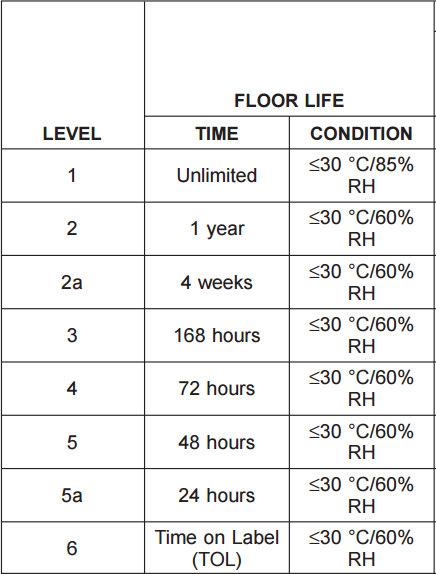
If these conditions have been exceeded, baking can be performed to reset the floor life of the components. The baking conditions also depend on different characteristics, such as MSL rating and component thickness (height). Please refer to IPC/JEDEC-STD-033 for baking conditions.
Quality and Reliability
What is voltage derating?
"Derating" is the name normally given to operating a component well inside its normal operating limits, in order to reduce the rate at which the component deteriorates.
Capacitors can be used at or near its rated voltage with the understanding that the failure rate at this voltage condition will typically be between 0.1 and 1% per 1000 hours of operation. Additionally, users can expect to see an increase in this failure rates after board mounting. Derating will drastically improve both the long-term reliability of the device and the initial power on performance.
Where do I obtain RoHS, REACH and material declaration documentation?
KEMET conducts its business in a manner designed to protect the health and safety of our employees, our customers, the public, and the environment. Please refer to the RoHS section of our website or contact your KEMET representative.
What is the outgassing performance of tantalum capacitors?
KEMET surface mount tantalum and polymer capacitors meet or exceed <1.0% TML and <0.1%CVCM per ASTM-E-595. A report summary is available upon request.
What is the tin whisker performance of tantalum capacitors?
KEMET surface mount tantalum capacitors are compliant with the tin whisker growth test methods and conditions per JESD-201 and JEDEC22a121.01. A report summary is available upon request.
What is the flammability rating of KEMET tantalum and polymer capacitors?
The encapsulation material used in all our tantalum and polymer capacitors meets a flammability rating of UL 94 V-0.
What is FIT/MTBF and how is it calculated?
The Failure In Time (FIT) rate of a device is the number of failures that can be expected in one billion (109) device-hours of operation. For example, 1000 devices for 1 million hours, or 1 million devices for 1000 hours each, or another combination. MTBF means Mean Time Between Failures, and it is the average time elapsed between two failures in the same asset.
KEMET provides FIT calculator software that is intended to follow the calculations spelled out in MIL-HDBK-217 (revision F) for the specific part types that KEMET manufactures.
What is SPICE and do you have models available?
The SPICE (Simulation Program with Integrated Circuit Emphasis) is a general-purpose, open-source analog electronic circuit simulator. It is a powerful program that is used in integrated circuit and board-level design to check the integrity of circuit designs and to predict circuit behavior. KEMET has a web-based SPICE tool named K-SIM which is available to use for free; it can export files to be used with some commercial versions of SPICE software.
What is failure rate and established reliability?
Failure rate is the frequency with which a component fails, expressed in failures per 1000 hours. Capacitors usually have a failure rate of 1%/1000 hours. However, established reliability levels are available usually in Military and HRA series. Users can select levels of established reliability to ensure a lower failure rate. For KEMET tantalum capacitors, it can be as low as 0.001% per 1000 hours of operation.
What is Weibull Grade and PCRAT?
Weibull analysis is a flexible measurement that details the probable distribution associated with the lifetime characteristics of a particular component. Particularly focused on failure-rate, Weibull distribution is used throughout reliability engineering to anticipate and account for issues of wear-out during development. While MIL-PRF-55365 Weibull grading is an accepted and useful failure rate estimation tool for MnO2 cathode tantalum capacitors, it is not well suited for use with tantalum polymer capacitors, which often are not prone to early failures. Because there are often no early failures when tantalum polymer capacitors are exposed to the allowed Weibull grading conditions, it is simply not possible to follow the procedure and perform the calculations for lack of the required time-to-failure data.
KEMET Polymer Capacitor Reliability Assessment Test (PCRAT) combines time proven testing concepts from the legacy military Established Reliability programs with modern voltage and temperature acceleration techniques that are specially tailored to the parts under test. The balance among sample size, accelerated test conditions, test duration, and failure criteria is chosen to allow practical estimation of the mounted-part failure rate of tantalum polymer capacitors. And so far, customer experience with capacitors evaluated with this new test strategy is very positive. For additional information, see Evaluation of Polymer Counter-Electrode Tantalum Capacitors for High Reliability Airborne Applications. (PDF)
What is KEMET F-Tech?
F-Tech eliminates hidden defects in the dielectric which continue to grow in the field, causing capacitor failures. The benefit of this technology is illustrated by a 2000 hours, 85°C, 1.32x rated voltage accelerated life test. The F-Tech parts see no degradation, while standard tantalums have 1.5 orders of magnitude degradation in leakage current.
What is KEMET Simulated Break-Down Screening (SBDS)?
The KEMET patented SBDS is a nondestructive testing technique that simulates the breakdown voltage (BDV) of a capacitor without damage to its dielectric or the general population of capacitors. This screening identifies hidden defects in the dielectric, providing the highest level of dielectric testing. SBDS is based on the simulation of breakdown voltage (BDV), the ultimate test of the dielectric in a capacitor. The benefit of SBDS is illustrated by a minimum breakdown voltage greater than 2x rated voltage, as compared to Weibull Graded parts with breakdown voltages as low as 1.25x rated voltage. Also, this is done without inducing wear out sometime associated with Weibull Grading.
How do I obtain qualification data for KEMET products?
Qualification data is available upon request. Please contact your KEMET representative for additional information.
Characteristics and Applications
Can tantalum and polymer capacitors operate applying reverse voltage?
Tantalum and polymer capacitors are polar devices and may be permanently damaged or destroyed if connected with the wrong polarity. A small degree of transient reverse voltage is permissible for short periods per the below table. The capacitors should not be operated continuously in reverse mode, even within these limits:
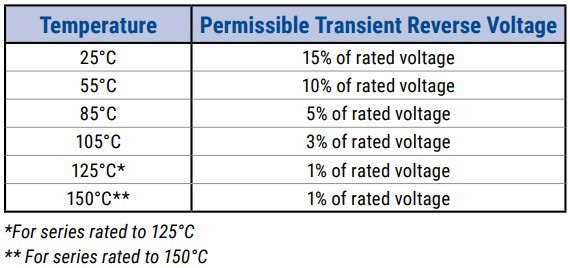
Does the capacitance change when a DC voltage is applied to tantalum and polymer capacitors?
Capacitance is virtually unchanged when voltage is applied. KEMET K-SIM can help visualize component behavior when changing different characteristics.
Does the capacitance change over time for tantalum and polymer capacitors?
Unlike ceramic capacitors, tantalum and polymer capacitors show very stable capacitance over time.
What is the frequency characteristic of capacitor's impedance?
KEMET datasheets show typical behavior. For more specific information, this can be simulated in K-SIM. See below for example:
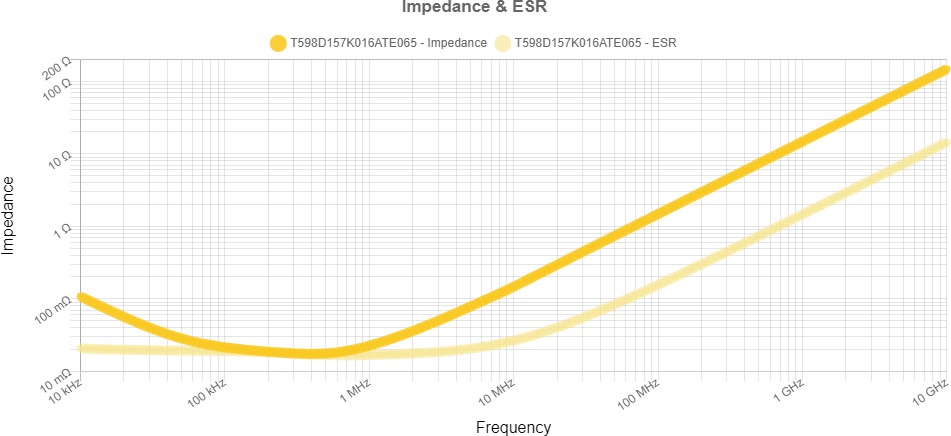
What is voltage derating and what are KEMET recommendations?
"Derating" is the name normally given to operating a component well inside its normal operating limits, in order to reduce the rate at which the component deteriorates.
Capacitors can be used at or near rated voltage with the understanding that the failure rate at this voltage condition will typically be between 0.1 and 1% per 1000 hours of operation. Additionally, users can expect to see an increase in this failure rates after board mounting. Derating will drastically improve both the long-term reliability of the device and the initial power on performance.
The higher the temperature, the lower the voltage. However, there are differences in derating depending on the capacitor/series being used. See one example below for an automotive application, for the recommended derating in one application assuming a Max Temperature of 105ºC and the impact it would require for a mission profile working at 125ºC. For additional information, see Derating Review of Ta-MNO2 vs. Ta-Polymer vs. Al-Polymer vs. NbO-MnO2. (PDF)
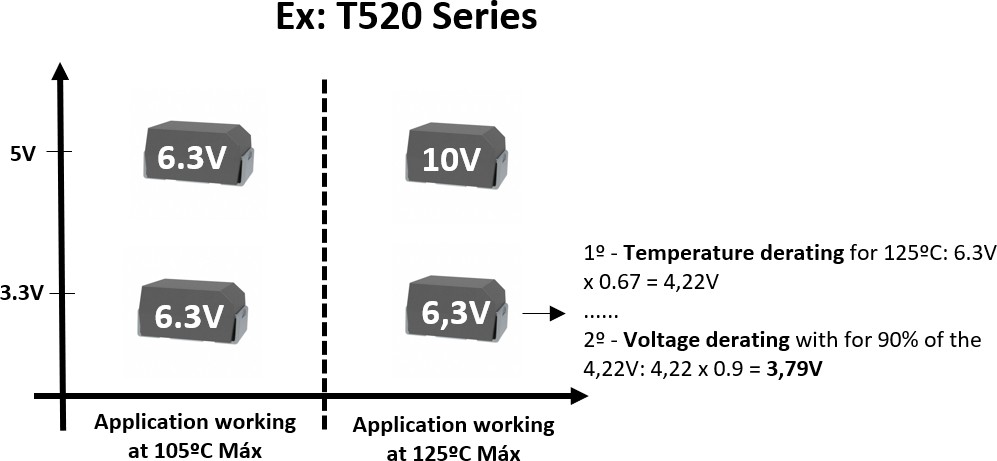
What is surge voltage?
Surge voltage is the maximum voltage (peak value) which may be applied to the capacitor for a short period. The surge voltage must not be applied for periodic charging and discharging in the course of normal operation, and cannot be part of the operation voltage.
The permissible surge voltage for all capacitors is 1.3 * VR. If voltage impulses (transient voltages) exceeding the surge voltage occur, this may lead to irreparable damage. If applications of this kind are planned, please consult us first.
For polymer automotive series, the following table can be considered as reference for max surge scenario (T598/T599):
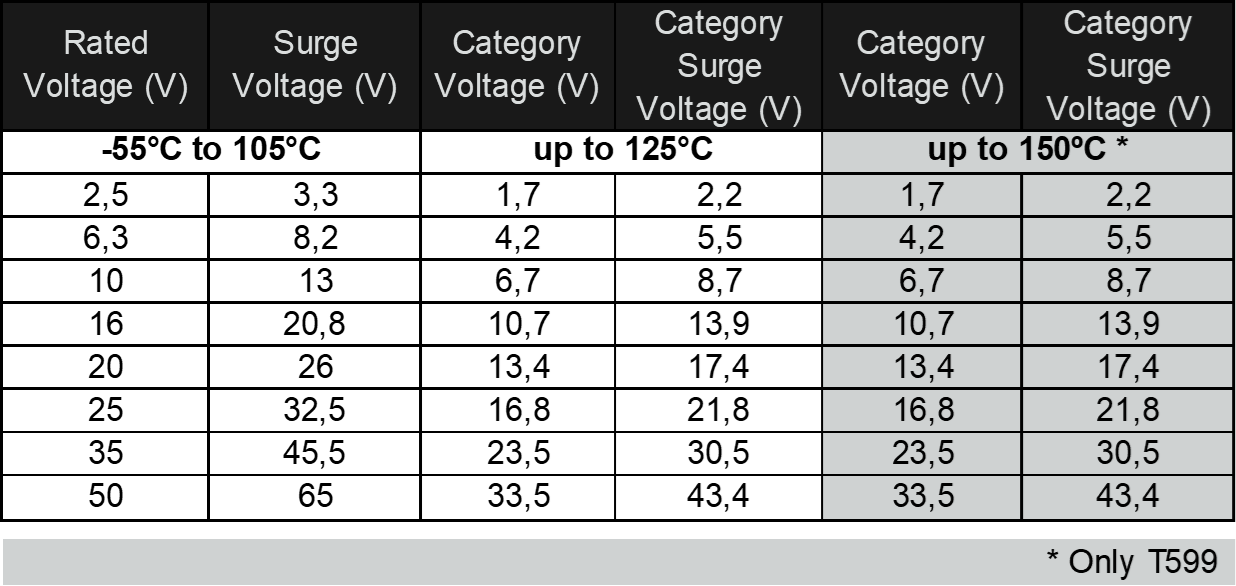
What is Impedance (Z)/Equivalent Series Resistance (ESR), and Equivalent Series Inductance (ESL)?
The impedance can be described as the absolute value of the AC resistance and is represented in close approximation by a series circuit comprising the following individual resistance components:
1. Effective reactance 1/ωC of the capacitance C.
2. Dielectric losses and the ohmic resistance of the electrolyte and/or the semiconductor layer (Equivalent Series Resistance (ESR)).
3. Effective reactance ωL of the inductance of the electrodes and the terminals.

ESL stands for Equivalent Series Inductance and is an important parameter that characterizes the behavior of capacitors in real-world circuits. Tantalum capacitors use tantalum metal as one of the electrodes, and they often incorporate a conductive polymer as the electrolyte. The use of conductive polymers helps enhance the performance of tantalum capacitors by reducing equivalent series resistance (ESR) compared to traditional tantalum capacitors with manganese dioxide electrolyte.
Equivalent Series Inductance (ESL) refers to the inductance that behaves similarly to the inherent inductance found in the capacitor within an electrical circuit. ESL becomes particularly relevant at higher frequencies and can impact the performance of the capacitor in certain applications. When working with polymer tantalum capacitors, engineers and designers need to consider ESL along with other parameters like ESR, capacitance, and voltage ratings to ensure that the chosen capacitor meets the specific requirements of the application. Minimizing ESL is often important in applications where low inductance is critical, such as in power delivery networks for high-speed digital systems.
The frequency and temperature relationship of tantalum MnO2 and polymer capacitors determine the impedance/ESR and ESL characteristics and can be checked in detail in K-SIM.
ESR includes both RDielect + RElyt. RDielect represents the dielectric losses and decreases with 1/ω. RElyt represents the series resistance of the electrolyte and does not vary with frequency. RDielect is negligible at frequencies above approximately 10 kHz. In the higher and lower frequency ranges, the frequency characteristic of the impedance is mainly caused by both the reactances. The temperature characteristic is mainly determined by the resistance of the electrolyte.
What is ripple current?
Ripple current in tantalum capacitors refers to the maximum alternating current (AC) that the capacitor can handle without experiencing degradation in performance or failure. Tantalum capacitors are commonly used in electronic circuits to filter and stabilize voltage. Ripple current is a crucial parameter, especially in applications where the capacitor is subjected to high-frequency AC signals or in power supply filtering.
Ripple current is typically specified in terms of root-mean-square (RMS) current. It represents the effective value of the alternating current flowing through the capacitor. When a tantalum capacitor is exposed to high ripple currents, it can generate heat due to the internal resistance of the capacitor material.
In general, lower ESR permits capacitors to be exposed to higher ripple currents and are typically assigned in a conservative way in the product datasheet. A small surface temperature rise is tolerated, and a corresponding maximum dissipated power is specified. Given the maximum allowed power and the maximum allowed ESR, the maximum allowed ripple current is easily calculated.
Therefore, when selecting a tantalum capacitor for a specific application, it's important to consider the ripple current rating and ensure that it can handle the expected AC load without overheating or compromising its performance.
For additional and more detailed information, please utilize K-SIM.
Can MLCCs be replaced with tantalum and polymer?
KEMET Electronics introduced the first to market AEC-Q200 Qualified series for automotive applications in August 2015, the T598. The initial design-in activities were done in Infotainment and ADAS (Advance Drive Assistance Systems) such as rear cameras and parking sensors. In 2016 KEMET expanded the T598 Portfolio to 35V and 50V capabilities and open a new frontier for automotive applications under Chassis and Safety. Now since 2018, KEMET continues leading the automotive solutions with the first to market introduction of a 150ºC product, the T599 Series.
The polymer automotive offering represents an opportunity for miniaturization and cost of overall solution reduction, and is important as an alternative in actual MLCC supply chain restrictions. For additional information, see Are Ta Polymer SMD Automotive Grade Capacitors an Alternative in the MLCC Supply Chain Issue?
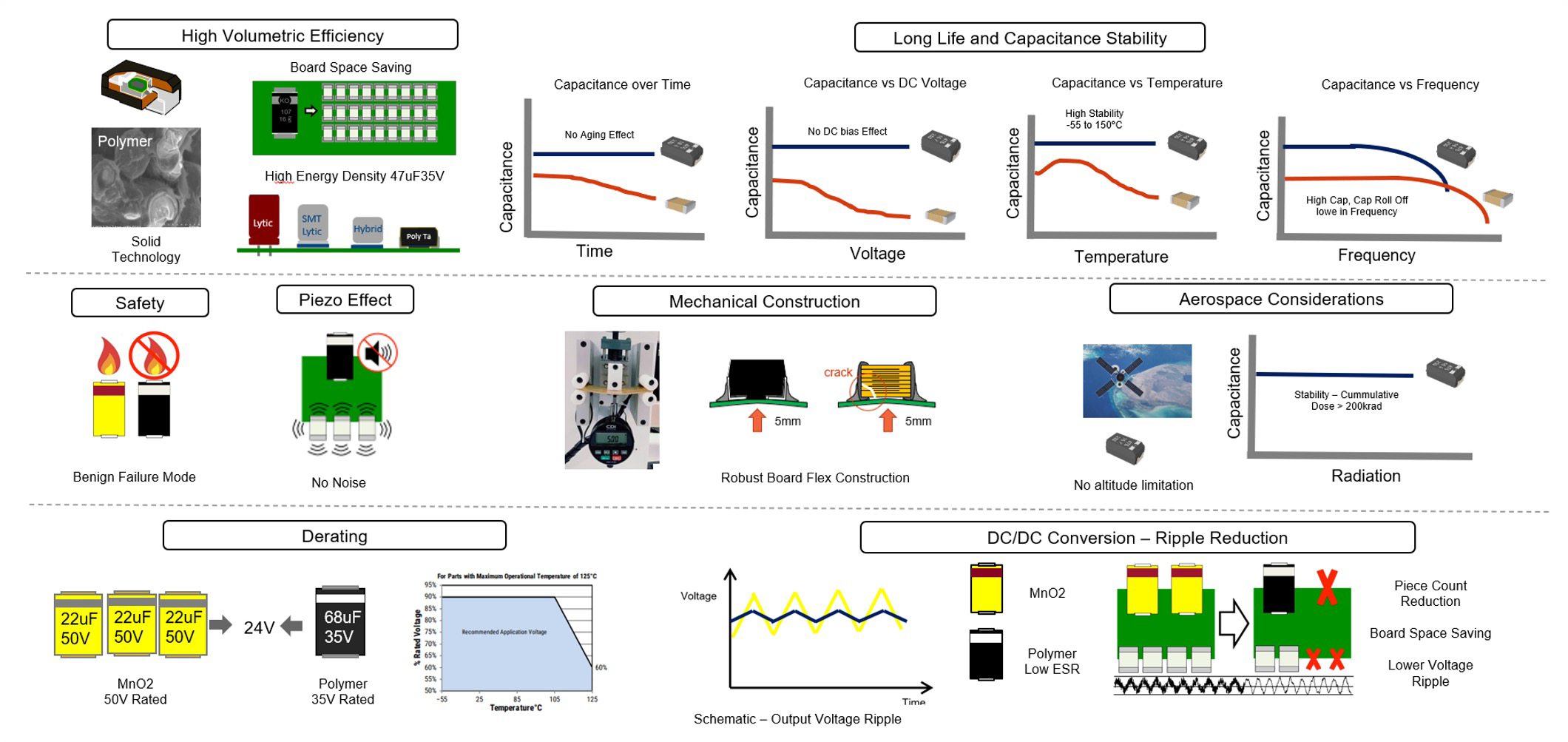
What is surge current?
Tantalum capacitors are typically used for reducing noise and stabilizing DC voltage in the power supply lines. When the power is turning on, high inrush currents through the capacitor are expected. For that reason, KEMET submits most of produced capacitors into a surge current testing in a 100% basis. Additionally, high reliability series (CWRs, HRAs, etc.) may be submitted to an extra testing step as an optional and defined in the product part number. For the testing conditions, the two references are the MIL-PRF-55365 and MIL-PRF-32700, where several options are available. The minimum peak charge/discharge current value applicable to each capacitor can be calculated according to: Vr/(1.0 + ESRCAP) where ESRCAP is:
At +25 ºC and +85 ºC, ESRCAP = specified ESR
At -55 ºC, ESRCAP = 2 times specified ESR
Are tantalum polymer capacitors sensitive to radiation?
Polymer tantalum capacitor technology was developed in response to demands from the market to lower the ESR of tantalum capacitors while preserving their small case size and high reliability. The higher quality interface between the dielectric and the polymer cathode increases the breakdown voltage of the device, as well as reducing its DC leakage current, even at extreme radiation exposure conditions. For addition information, see Radiation Characterisation for New Tantalum Polymer Capacitors. (PDF)
